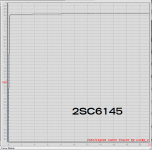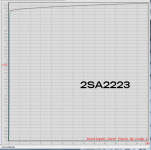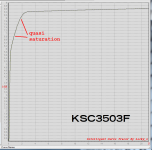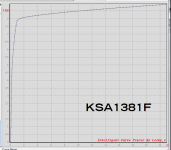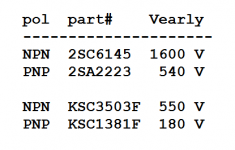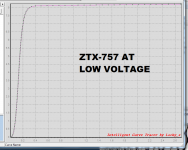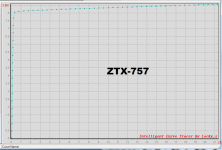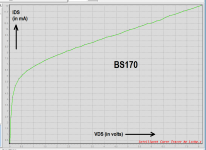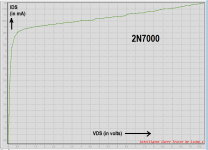A nice high Early Voltage is important in certain types of topology but this spec is hardly ever given in data sheets (although it can be estimated from family of characteristic curves). My question is does anyone have data as to which BJT's perform best in this respect? Especially complementary pairs. I would guess that video output transistors should be pretty good but would welcome further information from anyone who has looked into this.
A nice high Early Voltage is important in certain types of topology but this spec is hardly ever given in data sheets (although it can be estimated from family of characteristic curves). My question is does anyone have data as to which BJT's perform best in this respect? Especially complementary pairs. I would guess that video output transistors should be pretty good but would welcome further information from anyone who has looked into this.
2SA1381/2SC3503, in the 700-800V range. You'll have a hard time finding something better than this pair. In production at Fairchild, as KSA1381/KSC3503.
2SA1381/2SC3503, in the 700-800V range. You'll have a hard time finding something better than this pair. In production at Fairchild, as KSA1381/KSC3503.
Thanks Waly. Just the ticket 😉
2SA1381/2SC3503, in the 700-800V range. You'll have a hard time finding something better than this pair. In production at Fairchild, as KSA1381/KSC3503.
These devices are really impressive! Does anyone know of small signal transistors (like would be used in an input stage, current mirror, tail current source, etc.) with this type of performance?
There usually is some correlation to breakdown voltage. So you should look at the usual suspects like 2SC2240/2SA970 (now EOL but there are in-production SMD versions as well whose numbers I can't remember offhand) and KSC1845/KSA992. Their VA still isn't as high as this though. Making high-beta, high-Vbr / high Va transistors seemingly isn't easy. Use a cascode if need be.
There usually is some correlation to breakdown voltage. So you should look at the usual suspects like 2SC2240/2SA970 (now EOL but there are in-production SMD versions as well whose numbers I can't remember offhand) and KSC1845/KSA992. Their VA still isn't as high as this though. Making high-beta, high-Vbr / high Va transistors seemingly isn't easy. Use a cascode if need be.
So according to Toshiba's website, for the 2SC2240 they recommend the 2SC2713 or the 2SC4117 for new designs. I looked at the datasheet for both briefly and it seems like the only difference is the package.
For the 2SA970 they recommend the 2SA1163 or 2SA1587.
Really outstanding transistors, the hfe linearity is very good on both the NPN and PNP. But the Early voltage on the NPN looks quite a bit better judging from the plot in the datasheet.
Does anyone know...(like would be used in a... current mirror) with this type of performance?
Not really what you need in a current mirror, low Vce performance is what matters for this application.
Optimization for increased breakdown V tends to be detrimental to low Vce behaviour.
Search posts by "Keantoken" for more on this.
Best wishes
David
Not really what you need in a current mirror, low Vce performance is what matters for this application.
Optimization for increased breakdown V tends to be detrimental to low Vce behaviour.
Search posts by "Keantoken" for more on this.
Best wishes
David
Very interesting, I'll have to do some reading on this.
My thought process for using high Early voltage devices in a current mirror is that the output impedance of the mirror directly depends on the Early voltage.
Always more to learn!
These devices are really impressive! Does anyone know of small signal transistors (like would be used in an input stage, current mirror, tail current source, etc.) with this type of performance?
"Small signal" is not defined by the casing. By any metric (saturation, ICmax, etc...) these are "small signal" devices. The case helps dissipating a little more power and to conveniently attach a heat sink. You can also screw them together, face to face, for tight thermal coupling.
Sorry to join the discussion so late!
The highest Early voltages I've ever seen personally, were measured on the 2SC6145 (NPN) and the 2SA2223 (PNP). At least in my own testing, they masured higher than the previously-mentioned KSC3503/KSA1381 pair:
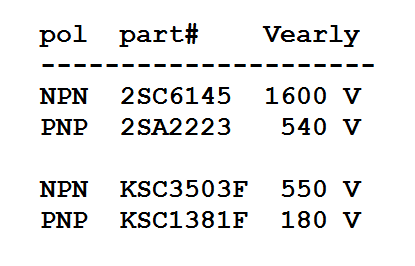 I-V curves below. The Early voltage is a measure of the "flatness" of the curve at high VCE. The flatter the curve, the higher the Vearly.
I-V curves below. The Early voltage is a measure of the "flatness" of the curve at high VCE. The flatter the curve, the higher the Vearly.
_
The highest Early voltages I've ever seen personally, were measured on the 2SC6145 (NPN) and the 2SA2223 (PNP). At least in my own testing, they masured higher than the previously-mentioned KSC3503/KSA1381 pair:
_
Attachments
Here's a bipolar transistor with a reasonably decent Early voltage. You can extract a pretty good numerical estimate of its Early voltage from the plots, simply by using good old Algebra-1. Slope = rise/run ; Y = (slope * X) + intercept
The choices of V1 and V2 are completely arbitrary; the ones I often use are 6.0V and 16.0V. Why did I pick those? because their delta is 10V which is an easy number to punch into a spreadsheet or pocket calculator!
_
- Vearly = [I1 * (V2-V1)/(I2-I1)] - V1
_
Attachments
The subject of the thread is any device, not only BJT. There are lot of mosfets with very high early (impedance) , as the most common 2n7000.
Immediately above, diyAudio member kokoriantz writes
I decided to measure that. 30 minutes ago I put two different MOSFETs on the curve tracer, a BS170 and a 2N7000. As you can see from their datasheets attached below, both of these are small signal devices in the TO-92 package.
Measured output conductance gds = (dIds / dVds) is quite high, which means that output impedance rds = 1/gds is quite low. These devices do not behave as kokoriantz predicted.
_
There are lot of mosfets with very high early (impedance) , as the most common 2n7000.
I decided to measure that. 30 minutes ago I put two different MOSFETs on the curve tracer, a BS170 and a 2N7000. As you can see from their datasheets attached below, both of these are small signal devices in the TO-92 package.
Measured output conductance gds = (dIds / dVds) is quite high, which means that output impedance rds = 1/gds is quite low. These devices do not behave as kokoriantz predicted.
_
Attachments
> 2n7000 as ccs
Then, with a Source resistor?
That causes a much higher Drain resistance than the naked device gives.
A CCS can sometimes use a Source resistor. (Particularly around high-voltage tubes.) Today's bump on all 'Early Effect' threads is about a power supply regulator (a Drain resistor would be wasteful). A related topic is high hOE for high gain in the VAS stage of an audio amplifier; in power amps, a large Drain resistor would be bad.
Then, with a Source resistor?
That causes a much higher Drain resistance than the naked device gives.
A CCS can sometimes use a Source resistor. (Particularly around high-voltage tubes.) Today's bump on all 'Early Effect' threads is about a power supply regulator (a Drain resistor would be wasteful). A related topic is high hOE for high gain in the VAS stage of an audio amplifier; in power amps, a large Drain resistor would be bad.
- Home
- Amplifiers
- Solid State
- Devices with high Early Voltage
 .....cascode!
.....cascode!